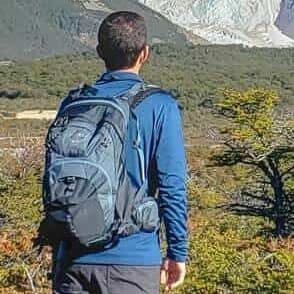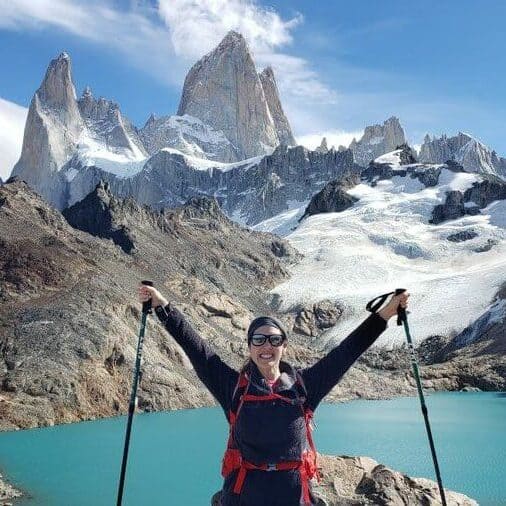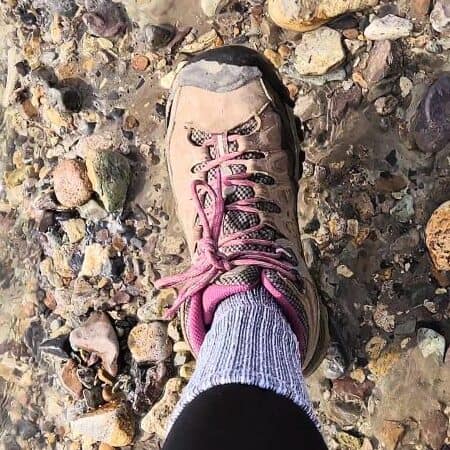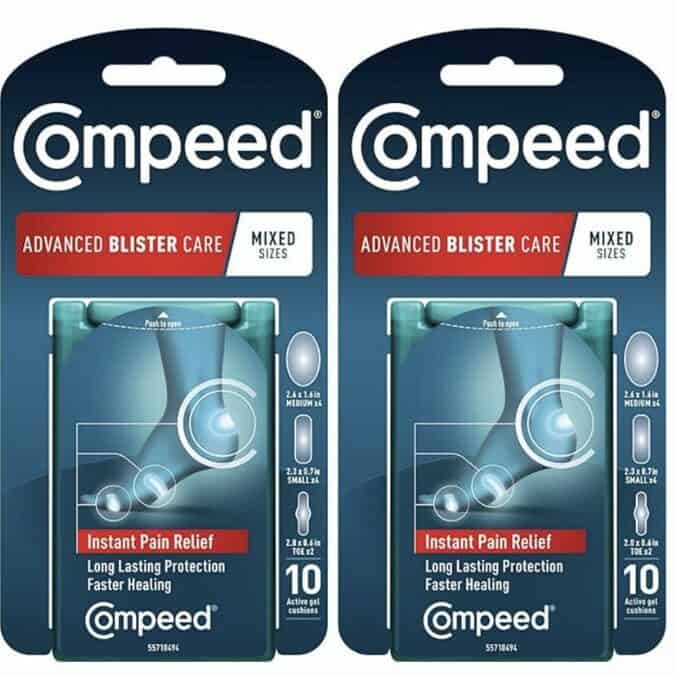Patagonia Packing List: What to Pack for El Chaltén, Argentina
Packing for Patagonia isn’t as simple as throwing a jacket and boots in a bag. Between the wild winds, four-seasons-in-a-day weather, and rugged trails around El Chaltén, it’s one of those trips where what you bring truly matters.
When we first planned our Patagonia adventure, every “packing list” we found online felt way too generic – or written by someone who hadn’t actually stood in 60 mph winds on the Fitz Roy trail. After spending multiple days hiking in El Chaltén, we learned what gear actually holds up (and what ends up buried at the bottom of your backpack).
This Patagonia packing list is based on our real experience hiking in El Chaltén – Argentina’s trekking capital – and it’s designed to help you stay warm, dry, and ready for anything. Whether you’re planning to hike Fitz Roy, Cerro Torre, or just explore town, these are the essentials that will make your trip easier, lighter, and way more comfortable.
Before diving in, here’s a quick list of what you’ll want to bring – and the exact gear we recommend after testing it on Patagonia’s trails.
Short on Time? Here are the key takeaways:
- Patagonia weather changes fast – layer smart and pack for all seasons, even in summer.
- A 25L day pack is perfect for El Chaltén day hikes like Fitz Roy and Cerro Torre.
- Must-have gear includes a rain shell, fleece, hydration pack, trekking poles, and a small first aid kit.
- Add-on essentials like emergency heat ponchos, blister kits, and microfiber towels can make or break your comfort.
- Keep your pack light, stay flexible, and always check the Monte Fitz Roy mountain forecast before heading out.
**Boozing Abroad contains affiliate links throughout the site. Read the full disclosure policy here** We are a participant in the Amazon Services LLC Associates Program, an affiliate advertising program designed to provide a means for us to earn fees by linking to Amazon.com and affiliated sites.
What to Pack for Patagonia: Complete Packing List for El Chaltén
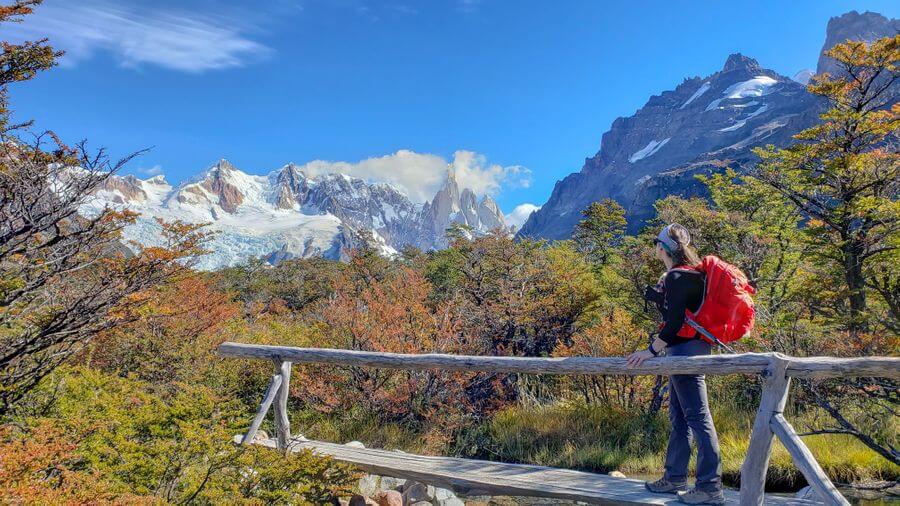
If you’re short on time (or space in your bag), here’s the quick version of what to pack for Patagonia.
This list is based on what we actually used while hiking in El Chaltén – from base layers to the day pack that survived the wind tunnels of Fitz Roy.
Clothing Essentials
- Lightweight base layers (top and bottom) for layering
- Warm fleece or mid-layer jacket
- Waterproof and windproof shell jacket
- Quick-dry hiking pants (convertible if possible)
- Moisture-wicking t-shirts or long sleeves
- Wool socks (bring extra pairs!)
- Warm hat and buff or neck gaiter
- Lightweight gloves
- Sturdy hiking boots with ankle support
Gear Must-Haves
- 20-30L day pack (we used Osprey)
- Rain cover for your backpack
- Trekking poles (essential for Fitz Roy and Cerro Torre)
- Refillable water bottle or hydration bladder
- Dry bag or zip pouches for electronics
- Portable power bank (Wi-Fi and cold drain batteries fast)
- Compact first aid kit
- Microfiber towel (for quick dries after rain)
Extras You’ll Be Glad You Packed
- Sunglasses with UV protection
- High SPF sunscreen and lip balm
- Snacks for long hikes (protein bars or nuts)
- Camera or GoPro with extra batteries
If you only remember one thing: Patagonia weather changes in minutes. Dress in layers, waterproof everything, and never underestimate the wind.
So if you’re wondering exactly what to wear and pack for hiking in Patagonia, keep reading. We’re breaking down every layer, piece of gear, and trail-tested essential you’ll want in your pack – plus our personal recommendations from hiking in El Chaltén, Argentina’s trekking capital.
Understanding Patagonia Weather (and Why It Matters When Packing)
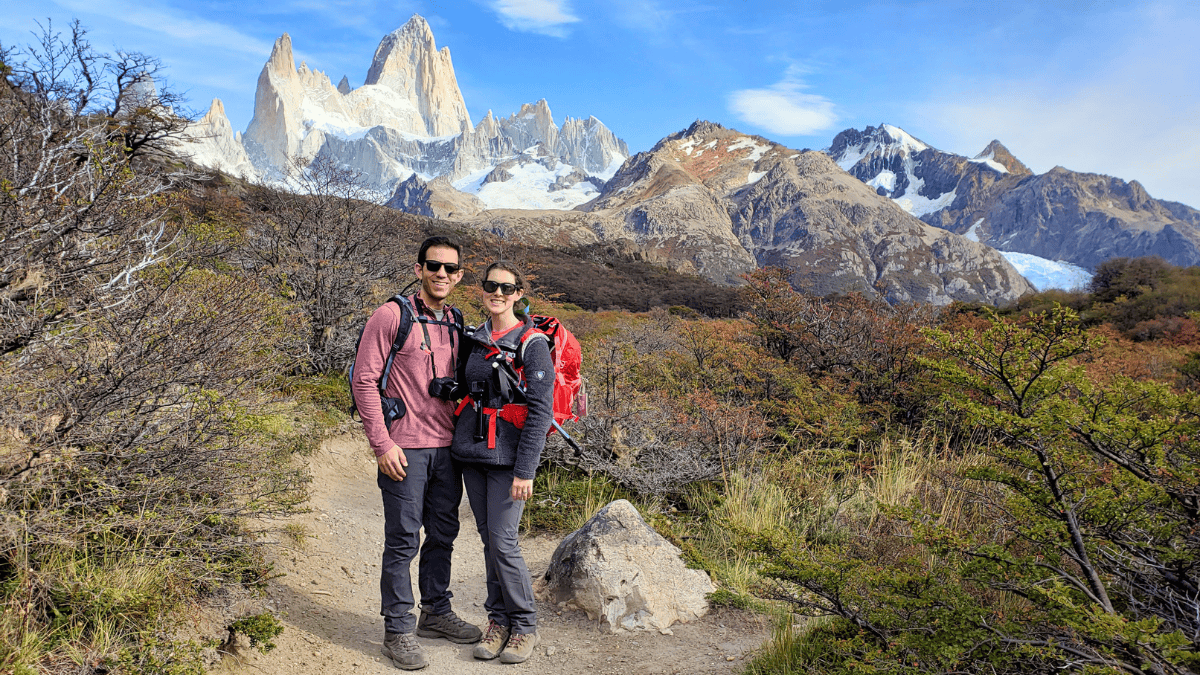
If there’s one thing you should know before hiking in Patagonia, it’s that the weather has a personality disorder. You can wake up to sunshine, hike through sleet by lunch, and end the day sunburned with windblown hair – all in a single afternoon.
That’s especially true in El Chaltén, where the mountains create their own microclimate. The town might be calm and clear, but just a few kilometers up the Fitz Roy or Cerro Torre trail, the wind can hit 60 mph (100 km/h), and temperatures can drop fast.
That’s why layering is everything here. Your Patagonia packing list should include moisture-wicking base layers, an insulating mid-layer (like fleece or down), and a waterproof outer shell. Together, they’ll keep you comfortable whether you’re hiking in sunshine or sideways rain.
Another must-pack? Windproof gear. Patagonia is famous for its gusts, and a solid rain jacket or wind shell can make or break your hike – especially if you’re crossing exposed ridgelines near the viewpoints.
And even though it’s tempting to bring heavy gear “just in case,” remember: you’ll be carrying everything on your back. Pack smart, not heavy – focus on versatile items that layer well and dry fast.
While our Patagonia hiking weather was perfect (which is rare), we did experience the full force of a storm during our last night in Patagonia and we wouldn’t want anyone to be caught unprepared in this environment if you were going out hiking. It will make your Patagonia hiking experience miserable if you aren’t prepared.
Clothing for Hiking in Patagonia
The secret to staying comfortable while hiking in Patagonia is simple: layer smart, not heavy.
El Chaltén’s weather changes faster than you can finish a sip of Malbec, so you’ll want gear that keeps you warm, dry, and flexible no matter what the sky throws your way.
Base Layers (Your Second Skin)
Start with lightweight, moisture-wicking base layers – both top and bottom. These help regulate body temperature and pull sweat away from your skin when you’re climbing steep trails like Fitz Roy.
We packed merino wool layers (smart move) because they’re breathable, odor-resistant, and surprisingly warm for their weight.
Mid Layers (Insulation You Can Trust)
Next up: your mid layer. Think fleece jacket that traps heat but doesn’t feel bulky.
We alternated between a fleece pullover and a thin packable down jacket depending on the day’s forecast – both fit easily under a rain shell and made those windy summit lunches a lot more tolerable.
Outer Layers (Your Weather Shield)
If Patagonia had a personality, it would be: “sunny and calm… until it’s not.” Your outer layer is your first line of defense against Patagonia’s notorious wind and rain. Whether you’re tackling Fitz Roy, Cerro Torre, or just walking through El Chaltén, the right jacket can make or break your comfort level.
A windproof, waterproof shell or rain jacket is non-negotiable here.
You’ll want two main pieces here:
- A lightweight rain shell for wind and water protection.
- Women’s Pick – 33,000 ft Lightweight Waterproof Windbreaker:
If you want reliable protection without the Patagonia price tag, this one’s a winner. It’s waterproof, windproof, and breathable with zippered pockets and an adjustable hood. It fits perfectly over a fleece or light down jacket, and it’s stylish enough to wear off the trail too. - Men’s Pick – Columbia Watertight II Jacket
This jacket is an affordable favorite for unpredictable weather. It’s completely waterproof, packs down small, and has adjustable cuffs and a drawstring hem to keep rain and wind out. We love that it’s light enough for hiking but durable enough to double as your everyday jacket while traveling.
- Women’s Pick – 33,000 ft Lightweight Waterproof Windbreaker:
- A light down puffer jacket for insulation on colder mornings or after-sunset walks back from dinner.
When choosing a down jacket, look for one that:
- Packs small (fits easily into your day pack)
- Weighs under 500 g
- Has a fill power of 700 or higher for warmth without bulk
When choosing your rain jacket, size up slightly to fit comfortably over your mid-layers or fleece. Always test your jacket before your trip to make sure it layers well and moves with you.
Bottoms
When you’re packing for Patagonia, your pants matter more than you think.
That’s why quick-dry, water-resistant hiking pants are essential here. Look for hiking pants made from nylon or polyester blends with a bit of stretch for movement and comfort. Many pairs also come with zip-off legs, giving you instant hiking shorts when the sun finally shows up.
Essential Gear for Hiking in Patagonia
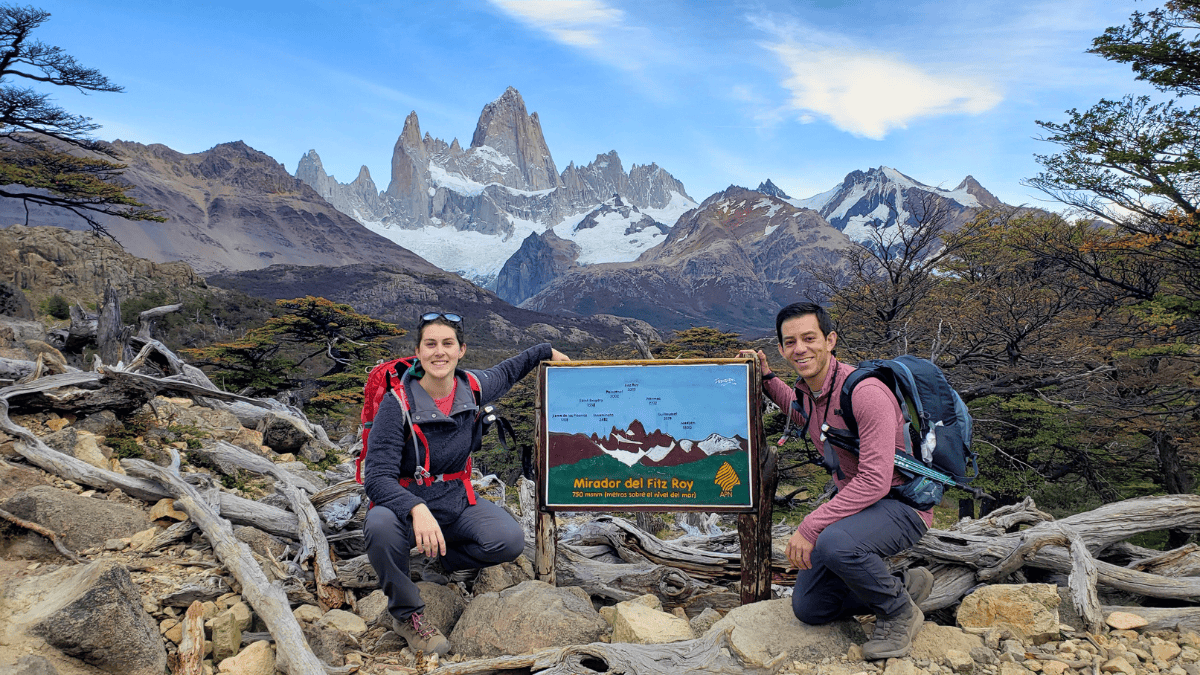
Whether you’re trekking to Laguna de los Tres or chasing waterfalls on a shorter trail, the right gear can turn a tough day into an unforgettable one. We learned this the hard way on our first hike in El Chaltén – Patagonia doesn’t mess around.
Day Pack (Your Adventure Basecamp)
Your day pack is your lifeline in Patagonia. From extra layers and snacks to your camera and water, this is the one item you’ll touch every single day – so it’s worth investing in a good one.
When choosing a hiking day pack, look for these key features:
- 24-30 liters of storage (perfect for full-day hikes like Fitz Roy or Cerro Torre)
- Hydration reservoir compatibility for easy drinking on the go
- Padded straps and hip belt to distribute weight comfortably
- Ventilated back panel – Patagonia hikes get sweaty fast, even in cold weather
We’ve used Osprey packs for years and can confidently say they’re the gold standard for day hiking. They’re durable, ergonomic, and backed by a lifetime guarantee – meaning this is one piece of gear you’ll never regret buying.
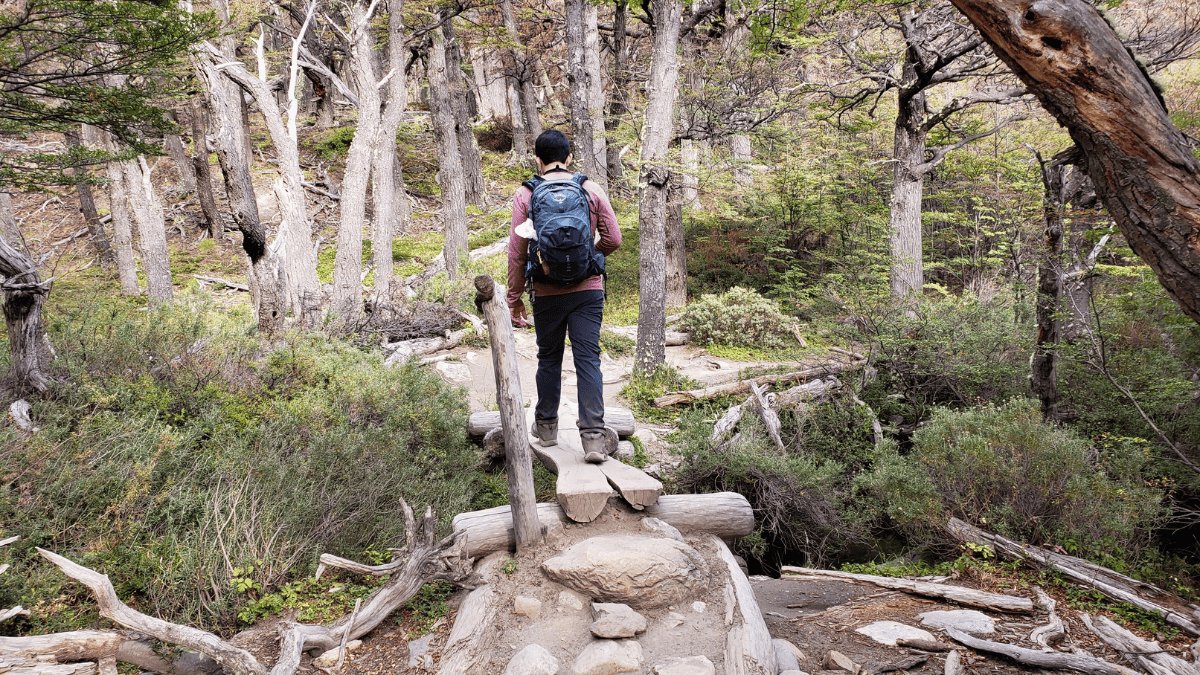
Men’s Pick: Osprey Day Hiking Hydration Packs
Designed with performance and comfort in mind, Osprey’s men’s hiking packs balance weight perfectly across your shoulders and hips. The hydration sleeve fits most 2L or 3L bladders, and the storage layout makes it easy to grab what you need mid-trail.
>> Explore men’s Osprey hiking packs on Amazon
Women’s Pick: Osprey Women’s Day Hiking Hydration Packs
Built specifically for women’s frames, these packs offer a slightly shorter torso length and contoured shoulder straps for a better fit. They’re lightweight yet tough enough for Patagonia’s unpredictable terrain.
>> Shop women’s Osprey hiking packs on Amazon
Even on “clear” days, Patagonia loves a surprise drizzle. Always bring a rain cover for your pack – most brands sell one that fits your specific model.
Water & Hydration
The good news? Patagonia’s water is some of the cleanest in the world. You can refill straight from glacial streams – just follow local guidance on where it’s safe to do so.
We carried a hydration bladder for hands-free sipping and a reusable bottle as backup. Skip single-use plastics entirely – it’s better for the planet and your backpack space.
Trekking Poles
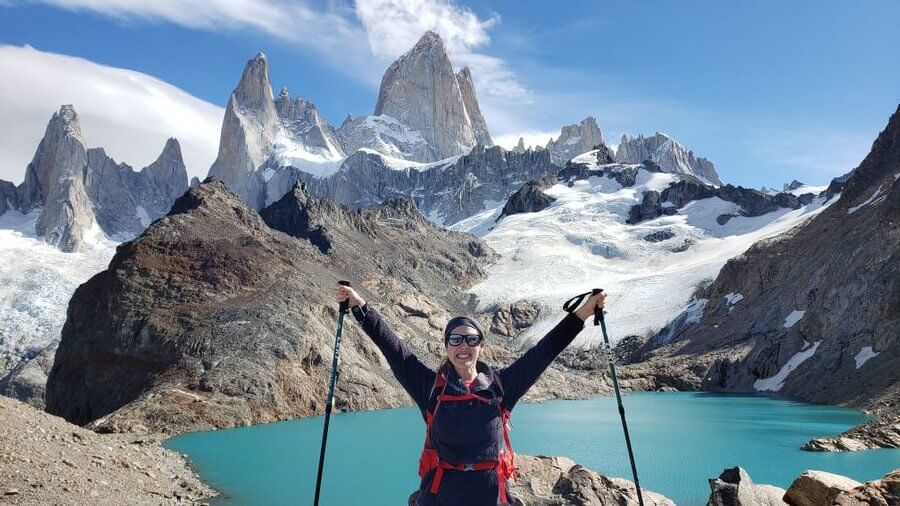
If you’re doing the Fitz Roy or Cerro Torre trails, trekking poles are game-changers. They take pressure off your knees during steep descents and help with balance when you’re crossing rocky terrain.
We rented ours in El Chaltén, but if you prefer your own, look for collapsible, lightweight aluminum poles that fit in your checked bag.
Electronics & Power
Cold temperatures drain batteries fast, and Wi-Fi barely exists in El Chaltén. Bring a solar power bank and keep your phone or camera batteries warm inside your jacket.
Emergency Heat Ponchos
While we didn’t need these on our Patagonia trip, we’ve used Emergency Heat Ponchos dozens of times on other hikes – and we’ll never travel without them again. They’re small, lightweight, and can save you from freezing if the weather turns on you (which, in Patagonia, it probably will). Even outside of Argentina, these are a smart addition to any hiking kit.
First Aid Kit
Being prepared for anything is non-negotiable when hiking in Patagonia. If you’re only doing day hikes like Fitz Roy or Cerro Torre, a compact First Aid Kit is perfect.
For multi-day treks or camping, we recommend a larger version with space for wraps, ointments, and blister care.
Blister Block Kits
Speaking of blister care, there’s nothing worse than feeling a blister halfway through a 16-mile hike. We swear by Compeed Blister Kits – nothing else even comes close.
We once shared a pack with a hiker we met on the trail, and by the summit, he came running over to take a photo of the box. His words, not ours: “These saved my feet.” Trust us – toss a few in your first aid kit. Make sure it’s the Compeed brand. We’ve tried others and they weren’t as good.
Quick-Dry Microfiber Towels
These small microfiber towels were one of our most-used Patagonia accessories. We used them for everything – wiping off rain, drying our hands after refilling hydration packs, and cleaning up after snacks on the trail.
They dry fast, weigh almost nothing, and most come with a hanging loop for clipping to your backpack.
Ladies Only: Female Urinary Director + Biodegradable Toilet Paper
We’re not exaggerating when we say this item changed the hiking game. A female urinary director lets you stand comfortably without the awkward forest squat.
The “toilets” on Fitz Roy and Cerro Torre are just four walls and a hole in the ground (and yes, it smells as bad as you’re imagining). With this, you can stay clean and stress-free.
Pair it with biodegradable toilet paper and a small trash bag for packing out used pieces – lightweight, eco-friendly, and zero-waste.
Buff, Neck Gaiter and hat
The wind here isn’t a gentle breeze – it’s full-body resistance training. A neck gaiter keeps dust, chill, and windburn at bay, especially on open ridgelines near Fitz Roy.
Snacks and Electrolytes
Argentinian bakeries sell incredible empanadas and sandwiches, but when you’re hours into a trail, you’ll want quick energy. Pack protein bars, trail mix, or Liquid IV (our favorite for long hikes and hot days).
Camera Gear and Extras
If photography is your thing, you’ll want wide-angle and zoom options for capturing Patagonia’s scale. We used a GoPro for windy hikes and a lightweight DSLR for scenic stops. Bring extra batteries – the cold drains them faster than you think.
Packing for a Patagonia Trip: Our Real Setup
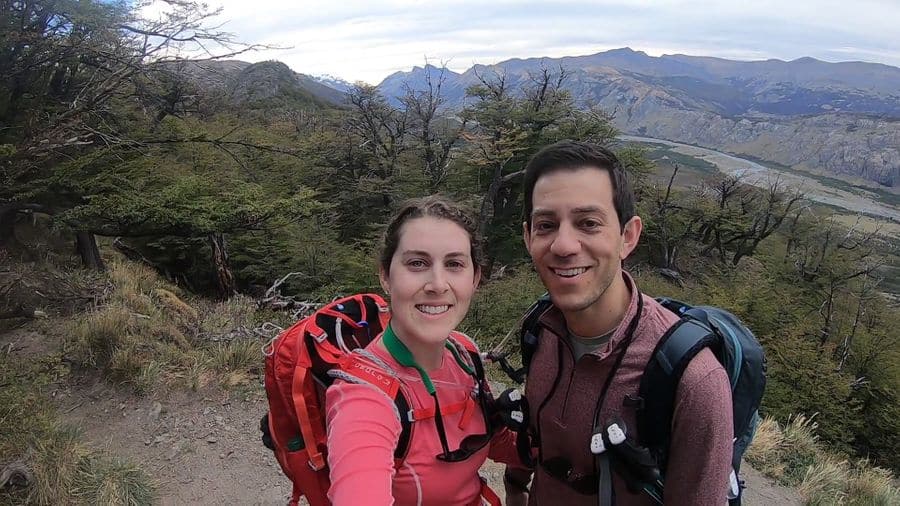
When we were prepping for El Chaltén, we read a ton of Patagonia packing lists – most of which made it sound like you needed to outfit an Antarctic expedition. Spoiler: you don’t.
You just need gear that works hard and packs light.
Here’s what we actually carried for our Patagonia hikes (and what we’d do again).
Inside Our Day Packs
We each carried a 25L day pack, which was plenty for long hikes like Fitz Roy and Cerro Torre. Here’s what we packed inside:
- Fleece or down jacket
- Rain shell
- Winter coat with removable layers (for early mornings)
- Lunch box (we bought one from the bakery next to Patagonia Hikes – highly recommend)
- 2.5L hydration bladder + refillable bottle
- Hydration powder for extra electrolytes
- Snacks: Honey Stinger Energy Waffles, protein bar, and a GU Energy Gel (not our favorite, but it did the trick)
- Power bank + charging cords
- Camera and GoPro
- Lightweight gloves and beanie
- Extra socks
- Pain relief (Tylenol and Advil)
- Insect repellent wipes + hand sanitizer
- Hand warmers
- Sunblock
- Matches and survival bracelet (gift from Samantha’s dad – didn’t need it, but good peace of mind)
- 2 plastic bags (one for trash, one for emergencies)
- Small first aid kit + blister care
- Headlamps (we brought two, just in case one died)
- Trekking poles (rented from Patagonia Hikes in El Chaltén)
- Emergency heat ponchos
Packing Tip: Organize your pack by priority: heavier items at the bottom, gear you’ll reach for often (like rain jackets and snacks) near the top. Patagonia weather can change without warning, so quick access matters.
Safety First – Check the Weather Before You Go
We visited El Chaltén in late summer (March) and had incredible luck with the weather – blue skies, clear peaks, and barely any wind for most of our trip. But on our last night, Patagonia reminded us who’s boss.
The wind cranked up to nearly 50 mph, rain started coming at us sideways, and within seconds of stepping outside, we were soaked. Luckily, we were on our way to the bus station and not camping or hiking.
It was the perfect reminder of how unpredictable Patagonia weather really is.
We packed our Patagonia hiking day packs for the worst-case scenario – not because we expected it, but because everyone we talked to said, “You’ll wish you had if you don’t.” We’d read countless stories from hikers who trekked three hours into Fitz Roy only to be slammed with rain, sleet, or even snow.
While we didn’t end up needing half of our emergency gear, we would’ve been warm, dry, and fed if the weather had turned. That’s what matters most.
Before you set out on any trail in Patagonia, always check the mountain weather forecast – it can change drastically between El Chaltén and the peaks.
You can find detailed wind and precipitation predictions for the area here: Monte Fitz Roy Mountain Forecast
Final Thoughts + Patagonia Packing Tips
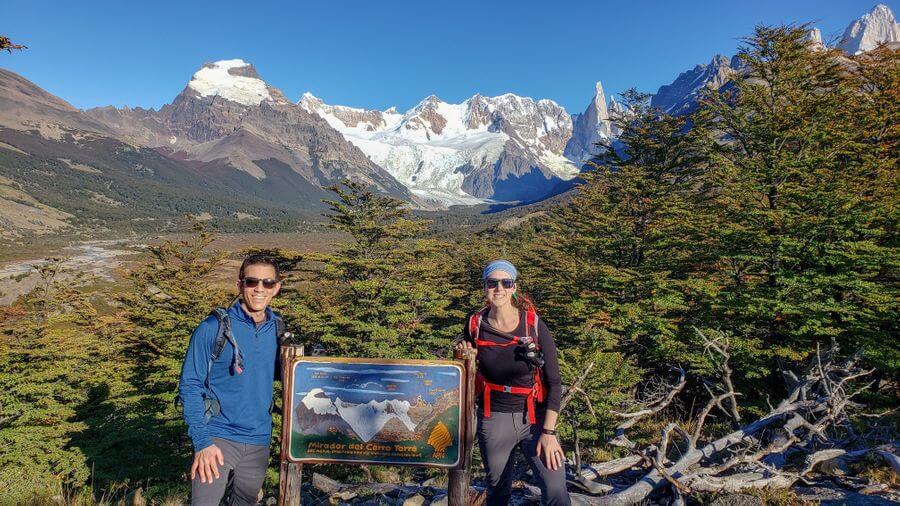
Packing for Patagonia doesn’t have to be overwhelming – it just takes a little planning and the right gear. The biggest lesson we learned while hiking in El Chaltén is that flexibility is everything. Layers, waterproof gear, and a solid day pack will carry you through nearly every type of weather Patagonia can throw your way.
Our advice? Pack light, layer up, and embrace the unpredictability. The wind will test your patience, but the views will make you forget every gust.
If you’re visiting El Chaltén, check out our guides to:
- The Complete Hiking Guide for Monte Fitz Roy Trek from El Chalten, Argentina
- Hiking Guide for Cerro Torre (Laguna Torre) from El Chalten, Argentina
- The Complete Guide to El Chalten Argentina – Patagonia Basecamp
Want to take your prep even further? Explore our full Argentina travel guides for itineraries, wine experiences, and destination tips across the country.
Ready to visit Patagonia? Read hotel reviews on TripAdvisor then book your room here!
Don’t forget to pick up a travel guidebook for your other adventures.
Love this guide? Have questions? Get in touch with us on Facebook | YouTube | Instagram | Pinterest

